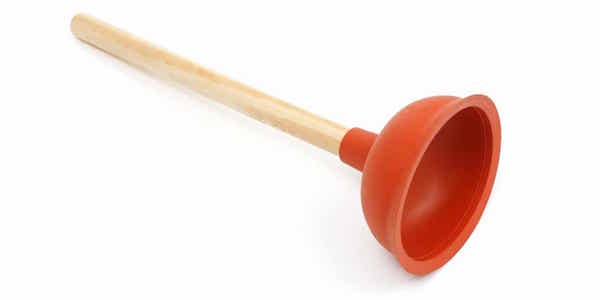You’ve finished washing the dishes after dinner, so you pull up the drain catcher to let the soapy water run down. Drying off your hands, you realize that the water in the sink has barely moved an inch. You reach into the basin to see if anything is covering the drain, but you find nothing. There’s no doubt about it: you have a blocked drain.
The first thing you should do when you notice a blocked sink drain is wait. It’s possible that the blockage is only slowing the water’s passage, not blocking it off completely. If the sink looks like it’s back to its regular state after an hour, you can use simple ingredients around the kitchen to clear stubborn build-up in the pipes.
The easiest way to unclog a drain is to put a half cup of baking soda and a whole cup of white vinegar directly into the drain and then wait for the chemical reaction to work for ten minutes. Then boil a kettle full of water and carefully pour it down the drain, making sure to avoid steam or splashing water.
If the soapy water doesn’t go down at all, you are dealing with a clog that needs a little more work. You can unclog a drain with a plunger by fitting the rubber cup directly over the drain hole and pumping it up and down, without letting the lips of the rubber cup leave the bottom of the sink. Repeat the action over and over, until you notice water moving down the drain.
Make sure to relegate specific plungers for different fixtures around the house. You should never use a plunger meant for a bathroom toilet to deal with a frustrating clog in your kitchen sink.
You should clean a plunger after every use to keep your home tidy and sanitary — it will also reduce any unpleasant smells carried by the residue. Rinse off the plunger, then spray it with your preferred disinfectant and then let it air dry. If you’re worried about dripping after using or cleaning it, put the plunger head in a plastic bag so you can easily move it without makes a mess on your floor.
When the water in the drain still won’t budge or when the problem resurfaces the next day, you need to call drain cleaning services in Toronto to inspect the drain with a camera and find out what is causing the problem. There will be situations where boiling water or five minutes with a plunger is not going to make a difference. The only way to get your plumbing back to normal is to call for professional intervention.
Sewer Drain Clog
This will be a bigger problem than your standard sink or toilet clog — it will stop any waste from exiting your plumbing system, forcing it to go back the way it came. You can tell that you have a sewer drain clog when several fixtures are clogged at the same time, when you find sewer back-up coming through drains or when you smell a foul odor.
Have a plumber do a video inspection to see exactly where the obstruction is in the sewer line. It’s possible that the obstruction is coming from the city’s side of the line. In that case, it would be the city’s responsibility to send workers to deal with the situation. The city will want you to prove that the problem is not on your side of the supply line, so you should ask the plumber to provide you with a copy of the video inspection with a time stamp as credible evidence.
Collapsed Pipes
One reason that your house might have bad drain problems is that it uses clay pipes for part of the sewer line — this used to be common practice when building residential homes in Toronto. Clay pipes can technically last for a long time, but they are delicate in comparison to other pipe materials. The material is brittle and sensitive to pressure, so it can easily break, collapse or get disjointed.
In this case, you will want to replace the broken pipe, along with other sections of clay pipe, with ones made of reliable materials. A popular choice is polyvinyl chloride pipe (PVC) because it is durable, it creates watertight joints and it is resistant to corrosion.
Tree Roots
What a lot of homeowners don’t know is that the trees planted in their front yards can wreak havoc on their plumbing systems. Stubborn blockages can be caused by tree roots that sneak into pipes through leaks and cracks. Older pipes made of delicate materials like clay are very susceptible to root intrusion.
Cutting down the tree will not prevent invasive roots from creeping into your plumbing and creating stubborn obstructions, because the root system will still grow below the stump even after the trunk is gone. City of Toronto experts recommend that homeowners prune the roots to keep them from spreading too far and make changes to their plumbing.
Look for plumbing services in Toronto to help you remove the root blockage from the pipes and inspect the system for additional leaks or cracks — small openings are how roots make their way inside. You will need to have the pipe removed and replaced immediately. If the pipes are made from a vulnerable material, you should think about getting all of them replaced. Otherwise, there is a risk that this root problem could happen all over again.
No matter what’s causing the blockage, we can help — we can fix problematic drains by cleaning out the exasperating clogs or by replacing the damaged pipes altogether. We are available twenty-four hours a day and seven days a week. There is no wrong time to call.
When your sink is draining slowly or when your toilet isn’t flushing on the first attempt, try simple DIY techniques to see if you can clear the problem. Sometimes, you can conquer your plumbing with hot water, a plunger and some elbow grease. If these techniques don’t make a difference, you know that it’s the right time to call an expert.





